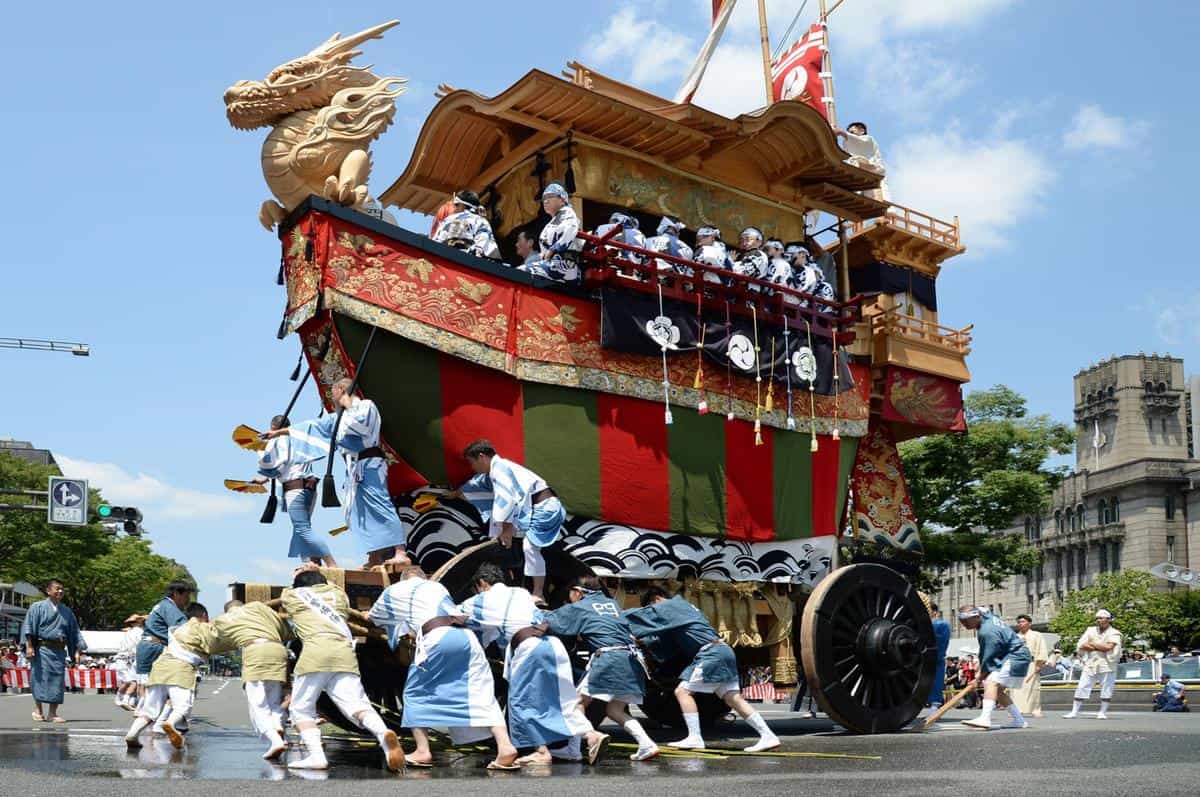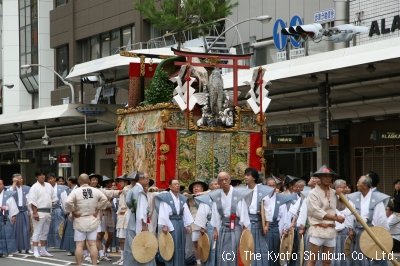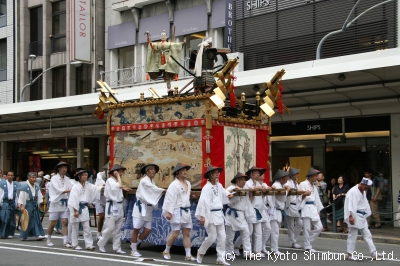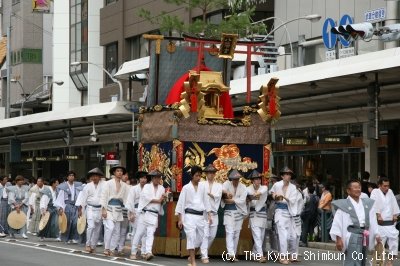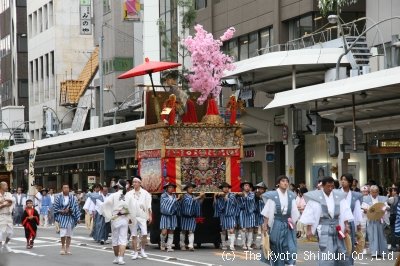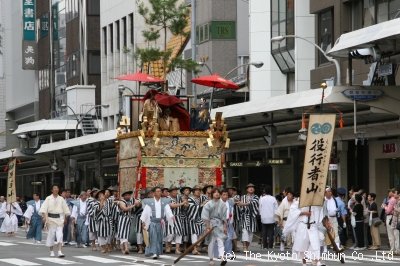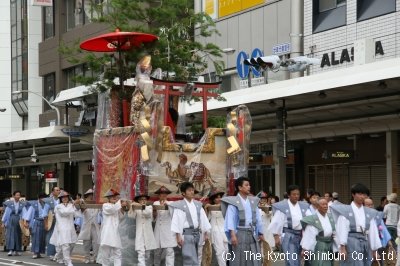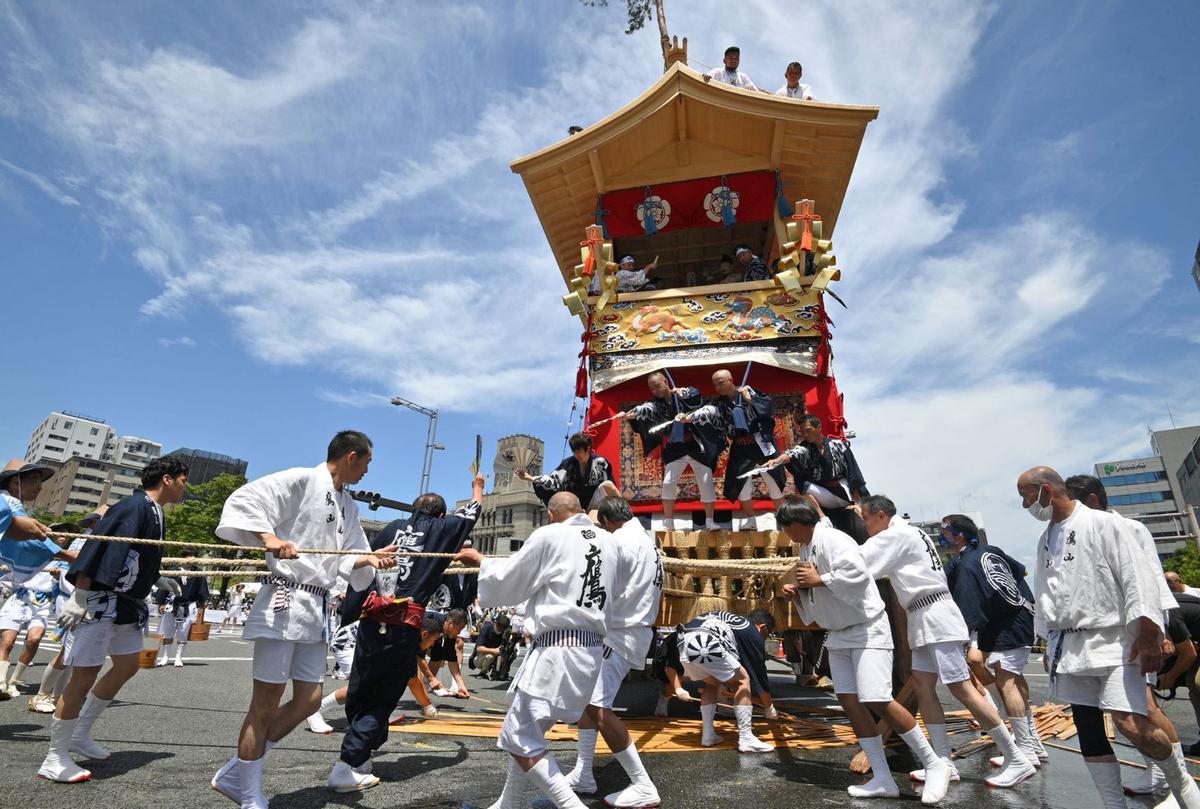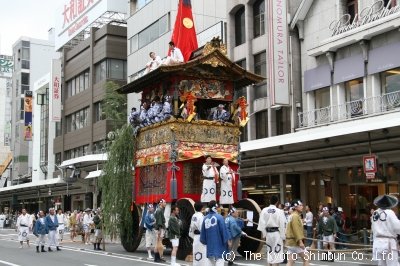後祭 祇園祭デジタル絵地図2025
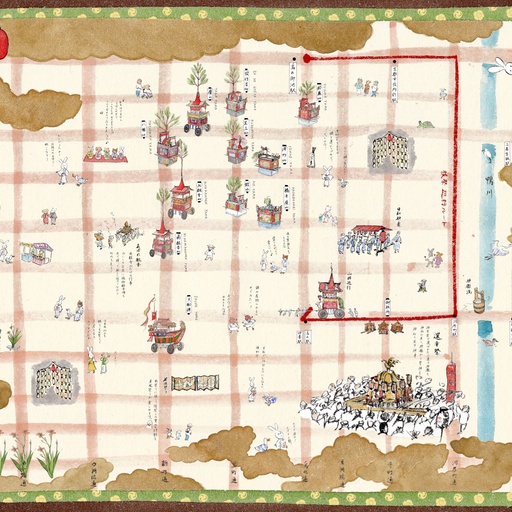
このマップは京都新聞社とStrolyでコラボレーションを行い、祇園祭を現地でも、おうちでも楽しめる祇園祭マップを作成しました。 マップ部分は完全手描きでの描き下ろし作品となり、「鳥獣戯画」を彷彿とさせる、個性豊かなキャラクターたちが祇園祭を楽しむ様子をご覧いただけます。 スポット情報では、京都新聞社提供の祇園祭に登場する各山鉾の情報はもちろん、祇園祭に関連する主要な神事や行事についてもご紹介。7月1日から31日まで開催される祇園祭を、余すことなくお届けします。
すべてのスポット情報
22件のスポット
 後祭 鉾一覧
後祭 鉾一覧
大船鉾(おおふねほこ)
![]() 後祭 鉾一覧
後祭 鉾一覧
2014年に150年ぶりに鉾で参加 巡行時の様子 かつて凱旋がいせん船鉾と呼ばれた。1864年の蛤はまぐり御門の変で焼失して巡行に参加できなくなった後は、神功皇后じんぐうこうごうのご神体や豪華な懸装品などを飾る「居祭り」を130年間続けてきた。高齢化や人手不足でいったん途絶えたが、1997年に青年層が囃子方を復活させた。2006年、懸装品を展示する「飾り席」が地元の四条町内で復活し、2012年から唐櫃からびつで巡行に復帰。2014年は150年ぶりに鉾で参加した。 INFO 【場所】新町通四条下ル 【日程】 鉾建:7/18 7:00〜曳初ひきぞめ:7/20 15:00〜宵山:7/21〜巡行:7/24 9:30〜 【Webサイト】 公益財団法人 大船鉾保存会 ←10番目(くじ取らず) 鷹山 → 京都新聞 動画ライブラリ 祇園祭の過去映像をご紹介。 他の祇園祭の過去映像はこちら(別タグで開きます。) 全方位で体感 ― 360度パノラマ映像 過去に撮影された山鉾の様子を360度パノラマ映像でご覧いただけます 別タグで開く 祇園祭入門 祇園祭とは 日本の三大祭の一つに挙げられる祇園祭は、毎年7月1日から31日までの1カ月間、京都市内の中心部や八坂神社(東山区)で行われる。クライマックスの山鉾巡行や神幸祭をはじめ、多彩な祭事が繰り広げられる。 祇園祭の由来と歴史 平安時代前期の869(貞観11)年、京で疫病が流行した際、広大な庭園だった神泉苑(中京区)に、当時の国の数にちなんで66本の鉾を立て、八坂神社の神輿を迎えて災厄が取り除かれるよう祈ったことが始まりとされる。 応仁の乱(1467~77年)で山鉾巡行は途絶えたが、1500(明応9)年に町衆の手で再興された。以後、中国やペルシャ、ベルギーなどからもたらされたタペストリーなどを各山鉾に飾るようになった。これらの懸装品の豪華さゆえに、山鉾は「動く美術館」とも呼ばれる。江戸時代にも火災に見舞われたが、町衆の力によって祭りの伝統は現代まで守られている。2009年にはユネスコ無形文化遺産に登録された。 山鉾巡行は本来、神輿渡御に伴う「露払い」の位置づけで、神幸祭に先立つ「前祭(さきまつり)」と還幸祭の「後祭(あとまつり)」がある。高度成長期以来、交通渋滞や観光促進を理由に、前祭と後祭の合同巡行が続いていたが、祭り本来の形を取り戻そうと分離が決定。2014年、約半世紀ぶりに後祭の山鉾巡行が復活した。 注連縄切りの大役を堂々と果たす長刀鉾稚児 祇園祭のスケジュール 毎年、7月1日の「吉符入り」で幕を開け、2日には山鉾巡行の順番を決める「くじ取り式」が京都市役所で行われる。10日頃から前祭の鉾建てが始まり、12日頃には鉾の「曳初(ひきぞ)め」がある。14日の宵々々山、15日の宵々山、16日の宵山を経て、17日は、前祭の23の山鉾が祇園囃子(ばやし)にのって京都のメーンストリートを巡行。 前祭山鉾巡行の翌日から、後祭に向けて鉾建てが始まる。21~23日は宵山期間で、24日は後祭の山鉾巡行。あわせて花笠巡行も繰り広げられる。夕方には、神輿が御旅所から神社に戻る還幸祭がある。 石段下を埋め尽くすように集まった担ぎ手たちが気勢を上げて3基のみこしを運ぶ。 祇園祭の見どころ 前祭・山鉾巡行まで 12日頃の「曳初(ひきぞ)め」は、女性を含む一般市民も参加できることが多い。16日の宵山までは、各山鉾町ではちょうちんの明かりに照らされた山や鉾が楽しめる。各山鉾では、病気除けとされるちまきや、学問成就や立身出世などのお守り(護符)を手に入れることもできる。 前祭・山鉾巡行当日 午前9時、計23基の山鉾が四条烏丸付近を出発。四条通を東へ向かった後、河原町通を北上し、御池通を西進する。四条麩屋町での長刀鉾稚児による「注連縄(しめなわ)切り」や、山鉾が各交差点で方向を変える「辻(つじ)回し」などが見どころ。 後祭・山鉾巡行まで 前祭の山鉾巡行の翌日から、大船鉾の鉾建てが始まる。宵山では露店の出店が規制され、本来の祭り情緒が楽しめそう。 後祭・山鉾巡行当日 午前9時半に計11基が烏丸御池を出発。前祭とは逆向きのコースを進む。復活した大船鉾や、前祭とは逆向きの辻回しなどに注目が集まる。後祭列が復活するまで長らく代わりとなっていた花傘巡行の行列も、後祭列を追うよう御池通や河原町通を進む。 車輪をきしませながら「辻回し」を披露する長刀鉾 (c) The Kyoto Shimbun Co.,Ltd. All rights reserved. ▲TOP
 後祭 山一覧
後祭 山一覧
前掛けや見送りは16世紀のベルギー製 巡行時の様子 前掛けや見送りは16世紀のベルギー製のタペストリーで、重要文化財に指定されている。ギリシャの叙事詩に題材をとって人物や風景が描かれており、山鉾きっての貴重なものだ。人物でなく、魚をテーマにするのは山のなかで唯一。竜門の滝をのぼる鯉は竜になるとの言い伝えで、木製の鯉が勢い良く水しぶきを上げる様は勇壮。 INFO 【場所】室町通六角下ル 【日程】 山建:7/19 9:00〜宵山:7/21〜巡行:7/24 9:30〜 【Webサイト】 公益財団法人 鯉山保存会 ←4番目 浄妙山 6番目(くじ取らず)→ 北観音山 京都新聞 動画ライブラリ 祇園祭の過去映像をご紹介。 他の祇園祭の過去映像はこちら(別タグで開きます。) 全方位で体感 ― 360度パノラマ映像 過去に撮影された山鉾の様子を360度パノラマ映像でご覧いただけます 別タグで開く 祇園祭入門 祇園祭とは 日本の三大祭の一つに挙げられる祇園祭は、毎年7月1日から31日までの1カ月間、京都市内の中心部や八坂神社(東山区)で行われる。クライマックスの山鉾巡行や神幸祭をはじめ、多彩な祭事が繰り広げられる。 祇園祭の由来と歴史 平安時代前期の869(貞観11)年、京で疫病が流行した際、広大な庭園だった神泉苑(中京区)に、当時の国の数にちなんで66本の鉾を立て、八坂神社の神輿を迎えて災厄が取り除かれるよう祈ったことが始まりとされる。 応仁の乱(1467~77年)で山鉾巡行は途絶えたが、1500(明応9)年に町衆の手で再興された。以後、中国やペルシャ、ベルギーなどからもたらされたタペストリーなどを各山鉾に飾るようになった。これらの懸装品の豪華さゆえに、山鉾は「動く美術館」とも呼ばれる。江戸時代にも火災に見舞われたが、町衆の力によって祭りの伝統は現代まで守られている。2009年にはユネスコ無形文化遺産に登録された。 山鉾巡行は本来、神輿渡御に伴う「露払い」の位置づけで、神幸祭に先立つ「前祭(さきまつり)」と還幸祭の「後祭(あとまつり)」がある。高度成長期以来、交通渋滞や観光促進を理由に、前祭と後祭の合同巡行が続いていたが、祭り本来の形を取り戻そうと分離が決定。2014年、約半世紀ぶりに後祭の山鉾巡行が復活した。 注連縄切りの大役を堂々と果たす長刀鉾稚児 祇園祭のスケジュール 毎年、7月1日の「吉符入り」で幕を開け、2日には山鉾巡行の順番を決める「くじ取り式」が京都市役所で行われる。10日頃から前祭の鉾建てが始まり、12日頃には鉾の「曳初(ひきぞ)め」がある。14日の宵々々山、15日の宵々山、16日の宵山を経て、17日は、前祭の23の山鉾が祇園囃子(ばやし)にのって京都のメーンストリートを巡行。 前祭山鉾巡行の翌日から、後祭に向けて鉾建てが始まる。21~23日は宵山期間で、24日は後祭の山鉾巡行。あわせて花笠巡行も繰り広げられる。夕方には、神輿が御旅所から神社に戻る還幸祭がある。 石段下を埋め尽くすように集まった担ぎ手たちが気勢を上げて3基のみこしを運ぶ。 祇園祭の見どころ 前祭・山鉾巡行まで 12日頃の「曳初(ひきぞ)め」は、女性を含む一般市民も参加できることが多い。16日の宵山までは、各山鉾町ではちょうちんの明かりに照らされた山や鉾が楽しめる。各山鉾では、病気除けとされるちまきや、学問成就や立身出世などのお守り(護符)を手に入れることもできる。 前祭・山鉾巡行当日 午前9時、計23基の山鉾が四条烏丸付近を出発。四条通を東へ向かった後、河原町通を北上し、御池通を西進する。四条麩屋町での長刀鉾稚児による「注連縄(しめなわ)切り」や、山鉾が各交差点で方向を変える「辻(つじ)回し」などが見どころ。 後祭・山鉾巡行まで 前祭の山鉾巡行の翌日から、大船鉾の鉾建てが始まる。宵山では露店の出店が規制され、本来の祭り情緒が楽しめそう。 後祭・山鉾巡行当日 午前9時半に計11基が烏丸御池を出発。前祭とは逆向きのコースを進む。復活した大船鉾や、前祭とは逆向きの辻回しなどに注目が集まる。後祭列が復活するまで長らく代わりとなっていた花傘巡行の行列も、後祭列を追うよう御池通や河原町通を進む。 車輪をきしませながら「辻回し」を披露する長刀鉾 (c) The Kyoto Shimbun Co.,Ltd. All rights reserved. ▲TOP
橋弁慶山(はしべんけいやま)
![]() 後祭 山一覧
後祭 山一覧
弁慶がなぎなたを構える場面の躍動感 巡行時の様子 山の御神体がなにを表すかは一目瞭然。五条の橋の上、牛若丸が軽々とぎぼしの上に飛び上がり、弁慶がなぎなたを構えるシーン。足駄の前歯だけで人形の体を支えるこの躍動感は、とても500年も前の造形とは思えない素晴らしさだ。かき山としてただ1つ、くじ取らずであったことや、山籠、真松もない形式からも、山の中では屈指の古いものであることが分かる。 INFO 【場所】蛸薬師通烏丸西入ル 【日程】 山建:7/21 8:00〜曳初ひきぞめ:7/21 11:00〜宵山:7/21〜巡行:7/24 9:30〜 【Webサイト】 公益財団法人 橋弁慶山保存会 ← 2番目(くじ取らず)→ 南観音山 京都新聞 動画ライブラリ 祇園祭の過去映像をご紹介。 他の祇園祭の過去映像はこちら(別タグで開きます。) 全方位で体感 ― 360度パノラマ映像 過去に撮影された山鉾の様子を360度パノラマ映像でご覧いただけます 別タグで開く 祇園祭入門 祇園祭とは 日本の三大祭の一つに挙げられる祇園祭は、毎年7月1日から31日までの1カ月間、京都市内の中心部や八坂神社(東山区)で行われる。クライマックスの山鉾巡行や神幸祭をはじめ、多彩な祭事が繰り広げられる。 祇園祭の由来と歴史 平安時代前期の869(貞観11)年、京で疫病が流行した際、広大な庭園だった神泉苑(中京区)に、当時の国の数にちなんで66本の鉾を立て、八坂神社の神輿を迎えて災厄が取り除かれるよう祈ったことが始まりとされる。 応仁の乱(1467~77年)で山鉾巡行は途絶えたが、1500(明応9)年に町衆の手で再興された。以後、中国やペルシャ、ベルギーなどからもたらされたタペストリーなどを各山鉾に飾るようになった。これらの懸装品の豪華さゆえに、山鉾は「動く美術館」とも呼ばれる。江戸時代にも火災に見舞われたが、町衆の力によって祭りの伝統は現代まで守られている。2009年にはユネスコ無形文化遺産に登録された。 山鉾巡行は本来、神輿渡御に伴う「露払い」の位置づけで、神幸祭に先立つ「前祭(さきまつり)」と還幸祭の「後祭(あとまつり)」がある。高度成長期以来、交通渋滞や観光促進を理由に、前祭と後祭の合同巡行が続いていたが、祭り本来の形を取り戻そうと分離が決定。2014年、約半世紀ぶりに後祭の山鉾巡行が復活した。 注連縄切りの大役を堂々と果たす長刀鉾稚児 祇園祭のスケジュール 毎年、7月1日の「吉符入り」で幕を開け、2日には山鉾巡行の順番を決める「くじ取り式」が京都市役所で行われる。10日頃から前祭の鉾建てが始まり、12日頃には鉾の「曳初(ひきぞ)め」がある。14日の宵々々山、15日の宵々山、16日の宵山を経て、17日は、前祭の23の山鉾が祇園囃子(ばやし)にのって京都のメーンストリートを巡行。 前祭山鉾巡行の翌日から、後祭に向けて鉾建てが始まる。21~23日は宵山期間で、24日は後祭の山鉾巡行。あわせて花笠巡行も繰り広げられる。夕方には、神輿が御旅所から神社に戻る還幸祭がある。 石段下を埋め尽くすように集まった担ぎ手たちが気勢を上げて3基のみこしを運ぶ。 祇園祭の見どころ 前祭・山鉾巡行まで 12日頃の「曳初(ひきぞ)め」は、女性を含む一般市民も参加できることが多い。16日の宵山までは、各山鉾町ではちょうちんの明かりに照らされた山や鉾が楽しめる。各山鉾では、病気除けとされるちまきや、学問成就や立身出世などのお守り(護符)を手に入れることもできる。 前祭・山鉾巡行当日 午前9時、計23基の山鉾が四条烏丸付近を出発。四条通を東へ向かった後、河原町通を北上し、御池通を西進する。四条麩屋町での長刀鉾稚児による「注連縄(しめなわ)切り」や、山鉾が各交差点で方向を変える「辻(つじ)回し」などが見どころ。 後祭・山鉾巡行まで 前祭の山鉾巡行の翌日から、大船鉾の鉾建てが始まる。宵山では露店の出店が規制され、本来の祭り情緒が楽しめそう。 後祭・山鉾巡行当日 午前9時半に計11基が烏丸御池を出発。前祭とは逆向きのコースを進む。復活した大船鉾や、前祭とは逆向きの辻回しなどに注目が集まる。後祭列が復活するまで長らく代わりとなっていた花傘巡行の行列も、後祭列を追うよう御池通や河原町通を進む。 車輪をきしませながら「辻回し」を披露する長刀鉾 (c) The Kyoto Shimbun Co.,Ltd. All rights reserved. ▲TOP
八幡山(はちまんやま)
![]() 後祭 山一覧
後祭 山一覧
鳥居の上に八幡さんのシンボルの鳩が2羽 巡行時の様子 八坂さんの祭りに石清水八幡をまつるのは不思議だが、当時それだけ八幡さんが信仰されていたあかしだろう。社殿は江戸時代後期天明年間の作と伝えられる総金箔押しの華麗なもの。前面の鳥居の笠木のうえに、向かい合って八幡さんのシンボルの鳩が2羽、止まっているのが愛らしい。 INFO 【場所】新町通三条下ル 【日程】 山建:7/20 16:00〜曳初ひきぞめ:7/20 16:00〜宵山:7/21〜巡行:7/24 9:30〜 【Webサイト】 公益財団法人 八幡山保存会 ←6番目(くじ取らず) 北観音山 8番目→ 黒主山 京都新聞 動画ライブラリ 祇園祭の過去映像をご紹介。 他の祇園祭の過去映像はこちら(別タグで開きます。) 全方位で体感 ― 360度パノラマ映像 過去に撮影された山鉾の様子を360度パノラマ映像でご覧いただけます 別タグで開く 祇園祭入門 祇園祭とは 日本の三大祭の一つに挙げられる祇園祭は、毎年7月1日から31日までの1カ月間、京都市内の中心部や八坂神社(東山区)で行われる。クライマックスの山鉾巡行や神幸祭をはじめ、多彩な祭事が繰り広げられる。 祇園祭の由来と歴史 平安時代前期の869(貞観11)年、京で疫病が流行した際、広大な庭園だった神泉苑(中京区)に、当時の国の数にちなんで66本の鉾を立て、八坂神社の神輿を迎えて災厄が取り除かれるよう祈ったことが始まりとされる。 応仁の乱(1467~77年)で山鉾巡行は途絶えたが、1500(明応9)年に町衆の手で再興された。以後、中国やペルシャ、ベルギーなどからもたらされたタペストリーなどを各山鉾に飾るようになった。これらの懸装品の豪華さゆえに、山鉾は「動く美術館」とも呼ばれる。江戸時代にも火災に見舞われたが、町衆の力によって祭りの伝統は現代まで守られている。2009年にはユネスコ無形文化遺産に登録された。 山鉾巡行は本来、神輿渡御に伴う「露払い」の位置づけで、神幸祭に先立つ「前祭(さきまつり)」と還幸祭の「後祭(あとまつり)」がある。高度成長期以来、交通渋滞や観光促進を理由に、前祭と後祭の合同巡行が続いていたが、祭り本来の形を取り戻そうと分離が決定。2014年、約半世紀ぶりに後祭の山鉾巡行が復活した。 注連縄切りの大役を堂々と果たす長刀鉾稚児 祇園祭のスケジュール 毎年、7月1日の「吉符入り」で幕を開け、2日には山鉾巡行の順番を決める「くじ取り式」が京都市役所で行われる。10日頃から前祭の鉾建てが始まり、12日頃には鉾の「曳初(ひきぞ)め」がある。14日の宵々々山、15日の宵々山、16日の宵山を経て、17日は、前祭の23の山鉾が祇園囃子(ばやし)にのって京都のメーンストリートを巡行。 前祭山鉾巡行の翌日から、後祭に向けて鉾建てが始まる。21~23日は宵山期間で、24日は後祭の山鉾巡行。あわせて花笠巡行も繰り広げられる。夕方には、神輿が御旅所から神社に戻る還幸祭がある。 石段下を埋め尽くすように集まった担ぎ手たちが気勢を上げて3基のみこしを運ぶ。 祇園祭の見どころ 前祭・山鉾巡行まで 12日頃の「曳初(ひきぞ)め」は、女性を含む一般市民も参加できることが多い。16日の宵山までは、各山鉾町ではちょうちんの明かりに照らされた山や鉾が楽しめる。各山鉾では、病気除けとされるちまきや、学問成就や立身出世などのお守り(護符)を手に入れることもできる。 前祭・山鉾巡行当日 午前9時、計23基の山鉾が四条烏丸付近を出発。四条通を東へ向かった後、河原町通を北上し、御池通を西進する。四条麩屋町での長刀鉾稚児による「注連縄(しめなわ)切り」や、山鉾が各交差点で方向を変える「辻(つじ)回し」などが見どころ。 後祭・山鉾巡行まで 前祭の山鉾巡行の翌日から、大船鉾の鉾建てが始まる。宵山では露店の出店が規制され、本来の祭り情緒が楽しめそう。 後祭・山鉾巡行当日 午前9時半に計11基が烏丸御池を出発。前祭とは逆向きのコースを進む。復活した大船鉾や、前祭とは逆向きの辻回しなどに注目が集まる。後祭列が復活するまで長らく代わりとなっていた花傘巡行の行列も、後祭列を追うよう御池通や河原町通を進む。 車輪をきしませながら「辻回し」を披露する長刀鉾 (c) The Kyoto Shimbun Co.,Ltd. All rights reserved. ▲TOP
黒主山(くろぬしやま)
![]() 後祭 山一覧
後祭 山一覧
大友黒主が志賀の桜を眺めるさまが主題 巡行時の様子 油天神山あぶらてんじんやまが梅なら、こちらは桜を松と共に飾り、華やいだ雰囲気をかもす。謡曲「志賀」のなかで、六歌仙の1人、大友黒主おおとものくろぬしが志賀の桜を眺めるさまをテーマにしている。杖をつき、白髪の髷まげの翁の人形は、いかにも品格がある。失火で町家ちょういえを失ったのを機に、5階建てビルにし、祭りのときだけ町会所にするのは時代をさきどりしたと話題になった。山を飾る桜の造花は、家に悪事を入れないお守になる。 INFO 【場所】室町通三条下ル 【日程】 山建:7/19 8:00〜宵山:7/21〜巡行:7/24 9:30〜 【Webサイト】 公益財団法人 黒主山保存会 ←7番目 八幡山 9番目→ 鈴鹿山 京都新聞 動画ライブラリ 祇園祭の過去映像をご紹介。 他の祇園祭の過去映像はこちら(別タグで開きます。) 全方位で体感 ― 360度パノラマ映像 過去に撮影された山鉾の様子を360度パノラマ映像でご覧いただけます 別タグで開く 祇園祭入門 祇園祭とは 日本の三大祭の一つに挙げられる祇園祭は、毎年7月1日から31日までの1カ月間、京都市内の中心部や八坂神社(東山区)で行われる。クライマックスの山鉾巡行や神幸祭をはじめ、多彩な祭事が繰り広げられる。 祇園祭の由来と歴史 平安時代前期の869(貞観11)年、京で疫病が流行した際、広大な庭園だった神泉苑(中京区)に、当時の国の数にちなんで66本の鉾を立て、八坂神社の神輿を迎えて災厄が取り除かれるよう祈ったことが始まりとされる。 応仁の乱(1467~77年)で山鉾巡行は途絶えたが、1500(明応9)年に町衆の手で再興された。以後、中国やペルシャ、ベルギーなどからもたらされたタペストリーなどを各山鉾に飾るようになった。これらの懸装品の豪華さゆえに、山鉾は「動く美術館」とも呼ばれる。江戸時代にも火災に見舞われたが、町衆の力によって祭りの伝統は現代まで守られている。2009年にはユネスコ無形文化遺産に登録された。 山鉾巡行は本来、神輿渡御に伴う「露払い」の位置づけで、神幸祭に先立つ「前祭(さきまつり)」と還幸祭の「後祭(あとまつり)」がある。高度成長期以来、交通渋滞や観光促進を理由に、前祭と後祭の合同巡行が続いていたが、祭り本来の形を取り戻そうと分離が決定。2014年、約半世紀ぶりに後祭の山鉾巡行が復活した。 注連縄切りの大役を堂々と果たす長刀鉾稚児 祇園祭のスケジュール 毎年、7月1日の「吉符入り」で幕を開け、2日には山鉾巡行の順番を決める「くじ取り式」が京都市役所で行われる。10日頃から前祭の鉾建てが始まり、12日頃には鉾の「曳初(ひきぞ)め」がある。14日の宵々々山、15日の宵々山、16日の宵山を経て、17日は、前祭の23の山鉾が祇園囃子(ばやし)にのって京都のメーンストリートを巡行。 前祭山鉾巡行の翌日から、後祭に向けて鉾建てが始まる。21~23日は宵山期間で、24日は後祭の山鉾巡行。あわせて花笠巡行も繰り広げられる。夕方には、神輿が御旅所から神社に戻る還幸祭がある。 石段下を埋め尽くすように集まった担ぎ手たちが気勢を上げて3基のみこしを運ぶ。 祇園祭の見どころ 前祭・山鉾巡行まで 12日頃の「曳初(ひきぞ)め」は、女性を含む一般市民も参加できることが多い。16日の宵山までは、各山鉾町ではちょうちんの明かりに照らされた山や鉾が楽しめる。各山鉾では、病気除けとされるちまきや、学問成就や立身出世などのお守り(護符)を手に入れることもできる。 前祭・山鉾巡行当日 午前9時、計23基の山鉾が四条烏丸付近を出発。四条通を東へ向かった後、河原町通を北上し、御池通を西進する。四条麩屋町での長刀鉾稚児による「注連縄(しめなわ)切り」や、山鉾が各交差点で方向を変える「辻(つじ)回し」などが見どころ。 後祭・山鉾巡行まで 前祭の山鉾巡行の翌日から、大船鉾の鉾建てが始まる。宵山では露店の出店が規制され、本来の祭り情緒が楽しめそう。 後祭・山鉾巡行当日 午前9時半に計11基が烏丸御池を出発。前祭とは逆向きのコースを進む。復活した大船鉾や、前祭とは逆向きの辻回しなどに注目が集まる。後祭列が復活するまで長らく代わりとなっていた花傘巡行の行列も、後祭列を追うよう御池通や河原町通を進む。 車輪をきしませながら「辻回し」を披露する長刀鉾 (c) The Kyoto Shimbun Co.,Ltd. All rights reserved. ▲TOP
南観音山(みなみかんのんやま)
![]() 後祭 山一覧
後祭 山一覧

楊柳観音像と善財童子像を安置 巡行時の様子 俗に「北観音山の観音様は男だが、南観音山は女性なので、南では宵山の夜更けに翌日の巡行の無事を祈って“あばれ観音"の行をされる」といういい伝えがあり、「あばれ観音」の別名がある。楊柳ようりゅう観音像と善財ぜんざい童子像を安置する。楊柳観音は、三十三観音の筆頭とされ、姿を変えて、手に柳を持ち薬師観音と同様に衆生の苦難を救う。この山の楊柳観音は頭から袈裟けさをつけ趺座ふざする。 INFO 【場所】新町通蛸薬師下ル 【日程】 山建:7/18 8:00〜曳初ひきぞめ:7/20 15:00〜宵山:7/21〜巡行:7/24 9:30〜 【Webサイト】 公益財団法人 祇園祭山鉾連合会 ←1番目(くじ取らず) 橋弁慶山 3番目→ 役行者山 京都新聞 動画ライブラリ 祇園祭の過去映像をご紹介。 他の祇園祭の過去映像はこちら(別タグで開きます。) 全方位で体感 ― 360度パノラマ映像 過去に撮影された山鉾の様子を360度パノラマ映像でご覧いただけます 別タグで開く 祇園祭入門 祇園祭とは 日本の三大祭の一つに挙げられる祇園祭は、毎年7月1日から31日までの1カ月間、京都市内の中心部や八坂神社(東山区)で行われる。クライマックスの山鉾巡行や神幸祭をはじめ、多彩な祭事が繰り広げられる。 祇園祭の由来と歴史 平安時代前期の869(貞観11)年、京で疫病が流行した際、広大な庭園だった神泉苑(中京区)に、当時の国の数にちなんで66本の鉾を立て、八坂神社の神輿を迎えて災厄が取り除かれるよう祈ったことが始まりとされる。 応仁の乱(1467~77年)で山鉾巡行は途絶えたが、1500(明応9)年に町衆の手で再興された。以後、中国やペルシャ、ベルギーなどからもたらされたタペストリーなどを各山鉾に飾るようになった。これらの懸装品の豪華さゆえに、山鉾は「動く美術館」とも呼ばれる。江戸時代にも火災に見舞われたが、町衆の力によって祭りの伝統は現代まで守られている。2009年にはユネスコ無形文化遺産に登録された。 山鉾巡行は本来、神輿渡御に伴う「露払い」の位置づけで、神幸祭に先立つ「前祭(さきまつり)」と還幸祭の「後祭(あとまつり)」がある。高度成長期以来、交通渋滞や観光促進を理由に、前祭と後祭の合同巡行が続いていたが、祭り本来の形を取り戻そうと分離が決定。2014年、約半世紀ぶりに後祭の山鉾巡行が復活した。 注連縄切りの大役を堂々と果たす長刀鉾稚児 祇園祭のスケジュール 毎年、7月1日の「吉符入り」で幕を開け、2日には山鉾巡行の順番を決める「くじ取り式」が京都市役所で行われる。10日頃から前祭の鉾建てが始まり、12日頃には鉾の「曳初(ひきぞ)め」がある。14日の宵々々山、15日の宵々山、16日の宵山を経て、17日は、前祭の23の山鉾が祇園囃子(ばやし)にのって京都のメーンストリートを巡行。 前祭山鉾巡行の翌日から、後祭に向けて鉾建てが始まる。21~23日は宵山期間で、24日は後祭の山鉾巡行。あわせて花笠巡行も繰り広げられる。夕方には、神輿が御旅所から神社に戻る還幸祭がある。 石段下を埋め尽くすように集まった担ぎ手たちが気勢を上げて3基のみこしを運ぶ。 祇園祭の見どころ 前祭・山鉾巡行まで 12日頃の「曳初(ひきぞ)め」は、女性を含む一般市民も参加できることが多い。16日の宵山までは、各山鉾町ではちょうちんの明かりに照らされた山や鉾が楽しめる。各山鉾では、病気除けとされるちまきや、学問成就や立身出世などのお守り(護符)を手に入れることもできる。 前祭・山鉾巡行当日 午前9時、計23基の山鉾が四条烏丸付近を出発。四条通を東へ向かった後、河原町通を北上し、御池通を西進する。四条麩屋町での長刀鉾稚児による「注連縄(しめなわ)切り」や、山鉾が各交差点で方向を変える「辻(つじ)回し」などが見どころ。 後祭・山鉾巡行まで 前祭の山鉾巡行の翌日から、大船鉾の鉾建てが始まる。宵山では露店の出店が規制され、本来の祭り情緒が楽しめそう。 後祭・山鉾巡行当日 午前9時半に計11基が烏丸御池を出発。前祭とは逆向きのコースを進む。復活した大船鉾や、前祭とは逆向きの辻回しなどに注目が集まる。後祭列が復活するまで長らく代わりとなっていた花傘巡行の行列も、後祭列を追うよう御池通や河原町通を進む。 車輪をきしませながら「辻回し」を披露する長刀鉾 (c) The Kyoto Shimbun Co.,Ltd. All rights reserved. ▲TOP
役行者山(えんのぎょうじゃやま)
![]() 後祭 山一覧
後祭 山一覧
人形が多く山のサイズも最大級 巡行時の様子 鈴鹿山と共に山鉾町最北の山。役行者えんのぎょうじゃは自ら修行するだけでなく、庶民の中に入って医療などにつとめた僧。古くから民衆に人気があった。人形3体はその役行者をまん中に、鬼の顔の一言主神ひとことぬしのかみ、葛城神かつらぎのかみ。三者の関係はさだかではないが、役行者が大峰山と葛城山のあいだに橋を架けようとして、鬼を使ったとの伝説によるらしい。人形が多いだけに山のサイズも大きい。 INFO 【場所】室町通三条上ル 【日程】 山建:7/19 6:00〜宵山:7/21〜巡行:7/24 9:30〜 【Webサイト】 公益財団法人 役行者山保存会 ←2番目(くじ取らず) 南観音山 4番目→ 浄妙山 京都新聞 動画ライブラリ 祇園祭の過去映像をご紹介。 他の祇園祭の過去映像はこちら(別タグで開きます。) 全方位で体感 ― 360度パノラマ映像 過去に撮影された山鉾の様子を360度パノラマ映像でご覧いただけます 別タグで開く 祇園祭入門 祇園祭とは 日本の三大祭の一つに挙げられる祇園祭は、毎年7月1日から31日までの1カ月間、京都市内の中心部や八坂神社(東山区)で行われる。クライマックスの山鉾巡行や神幸祭をはじめ、多彩な祭事が繰り広げられる。 祇園祭の由来と歴史 平安時代前期の869(貞観11)年、京で疫病が流行した際、広大な庭園だった神泉苑(中京区)に、当時の国の数にちなんで66本の鉾を立て、八坂神社の神輿を迎えて災厄が取り除かれるよう祈ったことが始まりとされる。 応仁の乱(1467~77年)で山鉾巡行は途絶えたが、1500(明応9)年に町衆の手で再興された。以後、中国やペルシャ、ベルギーなどからもたらされたタペストリーなどを各山鉾に飾るようになった。これらの懸装品の豪華さゆえに、山鉾は「動く美術館」とも呼ばれる。江戸時代にも火災に見舞われたが、町衆の力によって祭りの伝統は現代まで守られている。2009年にはユネスコ無形文化遺産に登録された。 山鉾巡行は本来、神輿渡御に伴う「露払い」の位置づけで、神幸祭に先立つ「前祭(さきまつり)」と還幸祭の「後祭(あとまつり)」がある。高度成長期以来、交通渋滞や観光促進を理由に、前祭と後祭の合同巡行が続いていたが、祭り本来の形を取り戻そうと分離が決定。2014年、約半世紀ぶりに後祭の山鉾巡行が復活した。 注連縄切りの大役を堂々と果たす長刀鉾稚児 祇園祭のスケジュール 毎年、7月1日の「吉符入り」で幕を開け、2日には山鉾巡行の順番を決める「くじ取り式」が京都市役所で行われる。10日頃から前祭の鉾建てが始まり、12日頃には鉾の「曳初(ひきぞ)め」がある。14日の宵々々山、15日の宵々山、16日の宵山を経て、17日は、前祭の23の山鉾が祇園囃子(ばやし)にのって京都のメーンストリートを巡行。 前祭山鉾巡行の翌日から、後祭に向けて鉾建てが始まる。21~23日は宵山期間で、24日は後祭の山鉾巡行。あわせて花笠巡行も繰り広げられる。夕方には、神輿が御旅所から神社に戻る還幸祭がある。 石段下を埋め尽くすように集まった担ぎ手たちが気勢を上げて3基のみこしを運ぶ。 祇園祭の見どころ 前祭・山鉾巡行まで 12日頃の「曳初(ひきぞ)め」は、女性を含む一般市民も参加できることが多い。16日の宵山までは、各山鉾町ではちょうちんの明かりに照らされた山や鉾が楽しめる。各山鉾では、病気除けとされるちまきや、学問成就や立身出世などのお守り(護符)を手に入れることもできる。 前祭・山鉾巡行当日 午前9時、計23基の山鉾が四条烏丸付近を出発。四条通を東へ向かった後、河原町通を北上し、御池通を西進する。四条麩屋町での長刀鉾稚児による「注連縄(しめなわ)切り」や、山鉾が各交差点で方向を変える「辻(つじ)回し」などが見どころ。 後祭・山鉾巡行まで 前祭の山鉾巡行の翌日から、大船鉾の鉾建てが始まる。宵山では露店の出店が規制され、本来の祭り情緒が楽しめそう。 後祭・山鉾巡行当日 午前9時半に計11基が烏丸御池を出発。前祭とは逆向きのコースを進む。復活した大船鉾や、前祭とは逆向きの辻回しなどに注目が集まる。後祭列が復活するまで長らく代わりとなっていた花傘巡行の行列も、後祭列を追うよう御池通や河原町通を進む。 車輪をきしませながら「辻回し」を披露する長刀鉾 (c) The Kyoto Shimbun Co.,Ltd. All rights reserved. ▲TOP
浄妙山(じょうみょうやま)
![]() 後祭 山一覧
後祭 山一覧
人目引くアクロバティックな人形の姿 巡行時の様子 橋弁慶山に似て、アクロバティックな人形の姿が人目を引く。宇治橋の上、宇治川の合戦。一来法師いちらいほうしが三井寺の僧兵・浄妙の頭上を飛び越して先陣をとった故事にちなむ。揺れる山の上で人形の上にさらに1体を乗せるのは強度の点で難しいが、1本の木で上下を繋ぐアイデアは素晴らしい。上下の人形を、上さま、下さまと呼ぶのもゆかしい。浄妙のよろいは室町時代のもので、重要文化財。 INFO 【場所】六角通室町東入ル 【日程】 山建:7/20 8:30〜宵山:7/21〜巡行:7/24 9:30〜 【Webサイト】 公益財団法人 祇園祭山鉾連合会 ←3番目 役行者山 5番目→ 鯉山 京都新聞 動画ライブラリ 祇園祭の過去映像をご紹介。 他の祇園祭の過去映像はこちら(別タグで開きます。) 全方位で体感 ― 360度パノラマ映像 過去に撮影された山鉾の様子を360度パノラマ映像でご覧いただけます 別タグで開く 祇園祭入門 祇園祭とは 日本の三大祭の一つに挙げられる祇園祭は、毎年7月1日から31日までの1カ月間、京都市内の中心部や八坂神社(東山区)で行われる。クライマックスの山鉾巡行や神幸祭をはじめ、多彩な祭事が繰り広げられる。 祇園祭の由来と歴史 平安時代前期の869(貞観11)年、京で疫病が流行した際、広大な庭園だった神泉苑(中京区)に、当時の国の数にちなんで66本の鉾を立て、八坂神社の神輿を迎えて災厄が取り除かれるよう祈ったことが始まりとされる。 応仁の乱(1467~77年)で山鉾巡行は途絶えたが、1500(明応9)年に町衆の手で再興された。以後、中国やペルシャ、ベルギーなどからもたらされたタペストリーなどを各山鉾に飾るようになった。これらの懸装品の豪華さゆえに、山鉾は「動く美術館」とも呼ばれる。江戸時代にも火災に見舞われたが、町衆の力によって祭りの伝統は現代まで守られている。2009年にはユネスコ無形文化遺産に登録された。 山鉾巡行は本来、神輿渡御に伴う「露払い」の位置づけで、神幸祭に先立つ「前祭(さきまつり)」と還幸祭の「後祭(あとまつり)」がある。高度成長期以来、交通渋滞や観光促進を理由に、前祭と後祭の合同巡行が続いていたが、祭り本来の形を取り戻そうと分離が決定。2014年、約半世紀ぶりに後祭の山鉾巡行が復活した。 注連縄切りの大役を堂々と果たす長刀鉾稚児 祇園祭のスケジュール 毎年、7月1日の「吉符入り」で幕を開け、2日には山鉾巡行の順番を決める「くじ取り式」が京都市役所で行われる。10日頃から前祭の鉾建てが始まり、12日頃には鉾の「曳初(ひきぞ)め」がある。14日の宵々々山、15日の宵々山、16日の宵山を経て、17日は、前祭の23の山鉾が祇園囃子(ばやし)にのって京都のメーンストリートを巡行。 前祭山鉾巡行の翌日から、後祭に向けて鉾建てが始まる。21~23日は宵山期間で、24日は後祭の山鉾巡行。あわせて花笠巡行も繰り広げられる。夕方には、神輿が御旅所から神社に戻る還幸祭がある。 石段下を埋め尽くすように集まった担ぎ手たちが気勢を上げて3基のみこしを運ぶ。 祇園祭の見どころ 前祭・山鉾巡行まで 12日頃の「曳初(ひきぞ)め」は、女性を含む一般市民も参加できることが多い。16日の宵山までは、各山鉾町ではちょうちんの明かりに照らされた山や鉾が楽しめる。各山鉾では、病気除けとされるちまきや、学問成就や立身出世などのお守り(護符)を手に入れることもできる。 前祭・山鉾巡行当日 午前9時、計23基の山鉾が四条烏丸付近を出発。四条通を東へ向かった後、河原町通を北上し、御池通を西進する。四条麩屋町での長刀鉾稚児による「注連縄(しめなわ)切り」や、山鉾が各交差点で方向を変える「辻(つじ)回し」などが見どころ。 後祭・山鉾巡行まで 前祭の山鉾巡行の翌日から、大船鉾の鉾建てが始まる。宵山では露店の出店が規制され、本来の祭り情緒が楽しめそう。 後祭・山鉾巡行当日 午前9時半に計11基が烏丸御池を出発。前祭とは逆向きのコースを進む。復活した大船鉾や、前祭とは逆向きの辻回しなどに注目が集まる。後祭列が復活するまで長らく代わりとなっていた花傘巡行の行列も、後祭列を追うよう御池通や河原町通を進む。 車輪をきしませながら「辻回し」を披露する長刀鉾 (c) The Kyoto Shimbun Co.,Ltd. All rights reserved. ▲TOP
鈴鹿山(すずかやま)
![]() 後祭 山一覧
後祭 山一覧
旧東海道の難所・鈴鹿峠が由来 巡行時の様子 鈴鹿山は、旧東海道の難所・鈴鹿峠をいう。畿内と東国を結ぶ要衝として、歴史上のエピソードも多い。商人を狙う盗賊が多かったことが、鬼が出る、に転化したようだ。この山の神・鈴鹿明神(瀬織津姫命せおりつひめのみこと)の伝説も鬼退治のおはなし。大なぎなたを手に、立て烏帽子の女神の姿がりりしい。 INFO 【場所】烏丸通三条上ル 【日程】 山建:7/20 8:00〜宵山:7/21〜巡行:7/24 9:30〜 【Webサイト】 公益財団法人 祇園祭山鉾連合会 ←8番目 黒主山 10番目(くじ取らず)→ 鷹山 京都新聞 動画ライブラリ 祇園祭の過去映像をご紹介。 他の祇園祭の過去映像はこちら(別タグで開きます。) 全方位で体感 ― 360度パノラマ映像 過去に撮影された山鉾の様子を360度パノラマ映像でご覧いただけます 別タグで開く 祇園祭入門 祇園祭とは 日本の三大祭の一つに挙げられる祇園祭は、毎年7月1日から31日までの1カ月間、京都市内の中心部や八坂神社(東山区)で行われる。クライマックスの山鉾巡行や神幸祭をはじめ、多彩な祭事が繰り広げられる。 祇園祭の由来と歴史 平安時代前期の869(貞観11)年、京で疫病が流行した際、広大な庭園だった神泉苑(中京区)に、当時の国の数にちなんで66本の鉾を立て、八坂神社の神輿を迎えて災厄が取り除かれるよう祈ったことが始まりとされる。 応仁の乱(1467~77年)で山鉾巡行は途絶えたが、1500(明応9)年に町衆の手で再興された。以後、中国やペルシャ、ベルギーなどからもたらされたタペストリーなどを各山鉾に飾るようになった。これらの懸装品の豪華さゆえに、山鉾は「動く美術館」とも呼ばれる。江戸時代にも火災に見舞われたが、町衆の力によって祭りの伝統は現代まで守られている。2009年にはユネスコ無形文化遺産に登録された。 山鉾巡行は本来、神輿渡御に伴う「露払い」の位置づけで、神幸祭に先立つ「前祭(さきまつり)」と還幸祭の「後祭(あとまつり)」がある。高度成長期以来、交通渋滞や観光促進を理由に、前祭と後祭の合同巡行が続いていたが、祭り本来の形を取り戻そうと分離が決定。2014年、約半世紀ぶりに後祭の山鉾巡行が復活した。 注連縄切りの大役を堂々と果たす長刀鉾稚児 祇園祭のスケジュール 毎年、7月1日の「吉符入り」で幕を開け、2日には山鉾巡行の順番を決める「くじ取り式」が京都市役所で行われる。10日頃から前祭の鉾建てが始まり、12日頃には鉾の「曳初(ひきぞ)め」がある。14日の宵々々山、15日の宵々山、16日の宵山を経て、17日は、前祭の23の山鉾が祇園囃子(ばやし)にのって京都のメーンストリートを巡行。 前祭山鉾巡行の翌日から、後祭に向けて鉾建てが始まる。21~23日は宵山期間で、24日は後祭の山鉾巡行。あわせて花笠巡行も繰り広げられる。夕方には、神輿が御旅所から神社に戻る還幸祭がある。 石段下を埋め尽くすように集まった担ぎ手たちが気勢を上げて3基のみこしを運ぶ。 祇園祭の見どころ 前祭・山鉾巡行まで 12日頃の「曳初(ひきぞ)め」は、女性を含む一般市民も参加できることが多い。16日の宵山までは、各山鉾町ではちょうちんの明かりに照らされた山や鉾が楽しめる。各山鉾では、病気除けとされるちまきや、学問成就や立身出世などのお守り(護符)を手に入れることもできる。 前祭・山鉾巡行当日 午前9時、計23基の山鉾が四条烏丸付近を出発。四条通を東へ向かった後、河原町通を北上し、御池通を西進する。四条麩屋町での長刀鉾稚児による「注連縄(しめなわ)切り」や、山鉾が各交差点で方向を変える「辻(つじ)回し」などが見どころ。 後祭・山鉾巡行まで 前祭の山鉾巡行の翌日から、大船鉾の鉾建てが始まる。宵山では露店の出店が規制され、本来の祭り情緒が楽しめそう。 後祭・山鉾巡行当日 午前9時半に計11基が烏丸御池を出発。前祭とは逆向きのコースを進む。復活した大船鉾や、前祭とは逆向きの辻回しなどに注目が集まる。後祭列が復活するまで長らく代わりとなっていた花傘巡行の行列も、後祭列を追うよう御池通や河原町通を進む。 車輪をきしませながら「辻回し」を披露する長刀鉾 (c) The Kyoto Shimbun Co.,Ltd. All rights reserved. ▲TOP
2022年196年ぶりに巡行本格復帰 巡行時の様子 応仁の乱以前からある曳山ひきやまだが、大火と大雨の被害で1827年以降、巡行していなかった。懸装品なども幕末の元治の大火(1864年)で焼失。御神体の頭部や鉦かねなど十数点が残っていた。巡行復帰を目指して、2014年には囃子方を結成。2019年から唐櫃からびつ巡行を実施。2022年に後祭に巡行復帰した。 INFO 【場所】三条通室町西入ル 【日程】 山建:7/18 8:00〜曳初ひきぞめ:7/20 15:00〜宵山:7/21〜巡行:7/24 9:30〜 【Webサイト】 公益財団法人 鷹山保存会 ←9番目 鈴鹿山 11番目(くじ取らず)→ 大船鉾 京都新聞 動画ライブラリ 祇園祭の過去映像をご紹介。 他の祇園祭の過去映像はこちら(別タグで開きます。) 全方位で体感 ― 360度パノラマ映像 過去に撮影された山鉾の様子を360度パノラマ映像でご覧いただけます 別タグで開く 祇園祭入門 祇園祭とは 日本の三大祭の一つに挙げられる祇園祭は、毎年7月1日から31日までの1カ月間、京都市内の中心部や八坂神社(東山区)で行われる。クライマックスの山鉾巡行や神幸祭をはじめ、多彩な祭事が繰り広げられる。 祇園祭の由来と歴史 平安時代前期の869(貞観11)年、京で疫病が流行した際、広大な庭園だった神泉苑(中京区)に、当時の国の数にちなんで66本の鉾を立て、八坂神社の神輿を迎えて災厄が取り除かれるよう祈ったことが始まりとされる。 応仁の乱(1467~77年)で山鉾巡行は途絶えたが、1500(明応9)年に町衆の手で再興された。以後、中国やペルシャ、ベルギーなどからもたらされたタペストリーなどを各山鉾に飾るようになった。これらの懸装品の豪華さゆえに、山鉾は「動く美術館」とも呼ばれる。江戸時代にも火災に見舞われたが、町衆の力によって祭りの伝統は現代まで守られている。2009年にはユネスコ無形文化遺産に登録された。 山鉾巡行は本来、神輿渡御に伴う「露払い」の位置づけで、神幸祭に先立つ「前祭(さきまつり)」と還幸祭の「後祭(あとまつり)」がある。高度成長期以来、交通渋滞や観光促進を理由に、前祭と後祭の合同巡行が続いていたが、祭り本来の形を取り戻そうと分離が決定。2014年、約半世紀ぶりに後祭の山鉾巡行が復活した。 注連縄切りの大役を堂々と果たす長刀鉾稚児 祇園祭のスケジュール 毎年、7月1日の「吉符入り」で幕を開け、2日には山鉾巡行の順番を決める「くじ取り式」が京都市役所で行われる。10日頃から前祭の鉾建てが始まり、12日頃には鉾の「曳初(ひきぞ)め」がある。14日の宵々々山、15日の宵々山、16日の宵山を経て、17日は、前祭の23の山鉾が祇園囃子(ばやし)にのって京都のメーンストリートを巡行。 前祭山鉾巡行の翌日から、後祭に向けて鉾建てが始まる。21~23日は宵山期間で、24日は後祭の山鉾巡行。あわせて花笠巡行も繰り広げられる。夕方には、神輿が御旅所から神社に戻る還幸祭がある。 石段下を埋め尽くすように集まった担ぎ手たちが気勢を上げて3基のみこしを運ぶ。 祇園祭の見どころ 前祭・山鉾巡行まで 12日頃の「曳初(ひきぞ)め」は、女性を含む一般市民も参加できることが多い。16日の宵山までは、各山鉾町ではちょうちんの明かりに照らされた山や鉾が楽しめる。各山鉾では、病気除けとされるちまきや、学問成就や立身出世などのお守り(護符)を手に入れることもできる。 前祭・山鉾巡行当日 午前9時、計23基の山鉾が四条烏丸付近を出発。四条通を東へ向かった後、河原町通を北上し、御池通を西進する。四条麩屋町での長刀鉾稚児による「注連縄(しめなわ)切り」や、山鉾が各交差点で方向を変える「辻(つじ)回し」などが見どころ。 後祭・山鉾巡行まで 前祭の山鉾巡行の翌日から、大船鉾の鉾建てが始まる。宵山では露店の出店が規制され、本来の祭り情緒が楽しめそう。 後祭・山鉾巡行当日 午前9時半に計11基が烏丸御池を出発。前祭とは逆向きのコースを進む。復活した大船鉾や、前祭とは逆向きの辻回しなどに注目が集まる。後祭列が復活するまで長らく代わりとなっていた花傘巡行の行列も、後祭列を追うよう御池通や河原町通を進む。 車輪をきしませながら「辻回し」を披露する長刀鉾 (c) The Kyoto Shimbun Co.,Ltd. All rights reserved. ▲TOP
北観音山(きたかんのんやま)
![]() 後祭 山一覧
後祭 山一覧
かつては南観音山と交代での順行 巡行時の様子 北観音山 応仁の乱の時代から隣町の南観音山と、1年おきの交代で山を出していたといわれる。隔年にでるというのは例がなく、この両山だけ。楊柳ようりゅう観音像と韋駄天いだてん立像を安置する。鉾ではないので真木しんぎの代わりに真松しんまつを立てる。松は、毎年鳴滝から届けられ、籤くじで所有を決めている。 INFO 【場所】新町通六角下ル 【日程】 山建:7/19 6:00〜曳初ひきぞめ:7/20 15:00〜宵山:7/21〜巡行:7/24 9:30〜 【Webサイト】 北觀音山 六角会 ←5番目 鯉山 7番目→ 八幡山 京都新聞 動画ライブラリ 祇園祭の過去映像をご紹介。 他の祇園祭の過去映像はこちら(別タグで開きます。) 全方位で体感 ― 360度パノラマ映像 過去に撮影された山鉾の様子を360度パノラマ映像でご覧いただけます 別タグで開く 祇園祭入門 祇園祭とは 日本の三大祭の一つに挙げられる祇園祭は、毎年7月1日から31日までの1カ月間、京都市内の中心部や八坂神社(東山区)で行われる。クライマックスの山鉾巡行や神幸祭をはじめ、多彩な祭事が繰り広げられる。 祇園祭の由来と歴史 平安時代前期の869(貞観11)年、京で疫病が流行した際、広大な庭園だった神泉苑(中京区)に、当時の国の数にちなんで66本の鉾を立て、八坂神社の神輿を迎えて災厄が取り除かれるよう祈ったことが始まりとされる。 応仁の乱(1467~77年)で山鉾巡行は途絶えたが、1500(明応9)年に町衆の手で再興された。以後、中国やペルシャ、ベルギーなどからもたらされたタペストリーなどを各山鉾に飾るようになった。これらの懸装品の豪華さゆえに、山鉾は「動く美術館」とも呼ばれる。江戸時代にも火災に見舞われたが、町衆の力によって祭りの伝統は現代まで守られている。2009年にはユネスコ無形文化遺産に登録された。 山鉾巡行は本来、神輿渡御に伴う「露払い」の位置づけで、神幸祭に先立つ「前祭(さきまつり)」と還幸祭の「後祭(あとまつり)」がある。高度成長期以来、交通渋滞や観光促進を理由に、前祭と後祭の合同巡行が続いていたが、祭り本来の形を取り戻そうと分離が決定。2014年、約半世紀ぶりに後祭の山鉾巡行が復活した。 注連縄切りの大役を堂々と果たす長刀鉾稚児 祇園祭のスケジュール 毎年、7月1日の「吉符入り」で幕を開け、2日には山鉾巡行の順番を決める「くじ取り式」が京都市役所で行われる。10日頃から前祭の鉾建てが始まり、12日頃には鉾の「曳初(ひきぞ)め」がある。14日の宵々々山、15日の宵々山、16日の宵山を経て、17日は、前祭の23の山鉾が祇園囃子(ばやし)にのって京都のメーンストリートを巡行。 前祭山鉾巡行の翌日から、後祭に向けて鉾建てが始まる。21~23日は宵山期間で、24日は後祭の山鉾巡行。あわせて花笠巡行も繰り広げられる。夕方には、神輿が御旅所から神社に戻る還幸祭がある。 石段下を埋め尽くすように集まった担ぎ手たちが気勢を上げて3基のみこしを運ぶ。 祇園祭の見どころ 前祭・山鉾巡行まで 12日頃の「曳初(ひきぞ)め」は、女性を含む一般市民も参加できることが多い。16日の宵山までは、各山鉾町ではちょうちんの明かりに照らされた山や鉾が楽しめる。各山鉾では、病気除けとされるちまきや、学問成就や立身出世などのお守り(護符)を手に入れることもできる。 前祭・山鉾巡行当日 午前9時、計23基の山鉾が四条烏丸付近を出発。四条通を東へ向かった後、河原町通を北上し、御池通を西進する。四条麩屋町での長刀鉾稚児による「注連縄(しめなわ)切り」や、山鉾が各交差点で方向を変える「辻(つじ)回し」などが見どころ。 後祭・山鉾巡行まで 前祭の山鉾巡行の翌日から、大船鉾の鉾建てが始まる。宵山では露店の出店が規制され、本来の祭り情緒が楽しめそう。 後祭・山鉾巡行当日 午前9時半に計11基が烏丸御池を出発。前祭とは逆向きのコースを進む。復活した大船鉾や、前祭とは逆向きの辻回しなどに注目が集まる。後祭列が復活するまで長らく代わりとなっていた花傘巡行の行列も、後祭列を追うよう御池通や河原町通を進む。 車輪をきしませながら「辻回し」を披露する長刀鉾 (c) The Kyoto Shimbun Co.,Ltd. All rights reserved. ▲TOP
 関連神事・行事
関連神事・行事
 コラム
コラム
「静」の祇園祭 #1
![]() コラム
コラム

巡行・渡御 中止の舞台裏 ~華美そぎ落とし 見えた その先~ コロナ禍で山鉾巡行が中止になった2020年の祇園祭 特別な年の祭りに、小説家、歌人、写真家、記者が それぞれのフィールドからアプローチする。 今年、京都は寂しい夏を迎えている。 コロナ禍の影響で、祇園祭のハイライト、豪華絢爛の山鉾やまほこの巡行が中止に追い込まれ、100万人近くが押し寄せる宵山行事も中止。「コンチキチン」の祇園囃子は聞こえない。近年知られるようになった勇壮な神輿渡御もない。 それでも、祇園祭は中止ではない。派手さはないが、京都は、変わらず祈りに包まれている。 祇園祭の神輿の1つ、中御座(中央)を清めた神輿洗い式。 例年は中御座を四条大橋に運んで清めるが、 今年は神輿渡御が中止となったため 神輿庫に収めたまま行われた (2020年7月10日 京都市東山区・八坂神社) 祇園祭は、平安時代から京の都から疫病の退散を祈る東山・八坂神社の祭礼だ。7月1日から31日までの1カ月間、氏子地域、すなわち神社への信仰を共にする人たちが住む京都市の下京、中京、東山の各区で、さまざまな神事が行われる。 千年を超す歴史も、規模も、華やかさも、日本一といって過言ではない。 大きく山鉾行事と神輿神事の2つに分けられ、特に山鉾は世界的に知られている。山鉾は中京区と下京区の町内に計33基あり、196年ぶりの復興を目指す1基が建設中だ。 長刀鉾保存会の代表者3人が 八坂神社に参拝した「お千度の儀」。 例年は稚児ちごと禿かむろを伴い参拝するが、 今年は巡行中止で稚児らが選ばれず、 役員のみが社参した。 本殿内で祈りを捧げた後、 本殿の周囲を3周し、手を合わせた。 (2020年7月1日、八坂神社) 山鉾は毎年7月にだけ姿を見せる。くぎを使わず縄を絡めて木材を固定して路上に建てられ、17日と24日に下京と中京を巡行する。かつて財を蓄えた京都の商人が競って買い求めた舶来のタペストリーや金工品で飾られることから、「動く美術館」とも称される。 コロナ禍を受けて、今年は祇園祭の最も華やかで勇壮な部分が中止に追い込まれた。ここにいたるまで、祭りに関わる人たちの間で葛藤があった。 神輿を清める神用水。 お祓いした後、夜の神輿洗い式までの間、 本殿前の舞殿に置かれた。 (2020年7月10日、八坂神社) 神輿を清める神用水 続きはこちら 箕浦成克(みのうら・しげかつ) 京都新聞社に1996年入社。長年、宗教担当として京都、滋賀の寺院と神社、伝統行事を中心に取材。現在、編集委員。世界にローマと京都にしかないといわれる「宗教記者会」に所属していた。 ※本記事は2020年7月13日に公開された記事です。 (c)The Kyoto Shimbun Co.,Ltd. All rights reserved.
「静」の祇園祭 #2
![]() コラム
コラム

山鉾巡行なき、その日 現れた裃かみしも姿の男たち 京都の中心部の四条通。 裃姿の男たちが現れた。 今年は豪華絢爛の山鉾巡行はなくても、 山鉾町には町衆の伝統をつなぐ姿があった。 綾傘鉾の吉符入り・清祓い。 町内の大原神社で行われた。 (2020年7月1日) Photo by 水沢圭介 祇園祭では「山車だし」という言葉は使わない。 「鉾」は2階建ての四輪構造、重さ10トン前後。 中央に真木しんぎと呼ばれる長さ20メートルを超す木の棒が取り付けられる。 「山」は、かつては担いで動かした 物語や伝説の一場面を、趣向を凝らした人形などで飾る舞台でもあり、真松しんまつといわれる本物の松を設置することが多い。 月鉾町の会所。 7月16日までの昼間 会所2階の窓から御神体人形が姿を見せた 山と鉾は、神輿みこしより後の14世紀、趣向を凝らした「風流ふりゅう拍子はやし物もの」として登場し、室町時代に下京、あるいは下辺しもわたりと呼ばれた地域を巡行した。戦火や大火による被害を乗り越えて、次第により大きく、より豪華になり、江戸時代の半ばにもなると神聖化されるようになる。 7月に入ると、八坂神社の氏子組織や山鉾町が行う神事始めの儀式がある。「吉符きっぷ入り」と呼んでいる。 函谷鉾の清祓い。 保存会の役員たちがかしわ手を打った (2020年7月1日) 7月1日午前、函谷かんこ鉾保存会は、町会所で吉符入りきっぷいりを行った。いつもは保存会の役員と、鉾を建てる大工方、手伝い方、車方、函谷鉾町の町内、将来の担い手である伝承委員ら計約70人が一堂に会するのに、コロナ禍の今年は時間を3回に分けた。 床の間は、「祇園牛頭ごず天王」と書かれた軸、お社、稚児ちご人形などをいつも通りに飾った。献酒もずらりと並んだ。 「今年は静かに祈りを捧げてほしい」。 神職が挨拶した。 町衆の心意気変わらず 保存会の岡本正理事長(54)は山鉾町らしく、「34の山鉾は町衆が競い合って発展してきた。うちこそが一番だと、どこも思っている。コロナの時でも、先祖たちが継いできた町衆の心意気は今年も変わらず大事にしたい」と語った。 函谷鉾保存会の床の間に飾られた御神体人形 (2020年7月1日) 町衆は「まちしゅう」とも「ちょうしゅう」とも読む。室町時代以降に登場した、自治意識の高い商工業者を指す。現在は、かつて町衆が運営した山鉾を受け継ぐ者として、意気込みも継承したいと願っている。 一方で、長刀鉾保存会は、例年5日に行う「吉符入り」はしなかった。 真剣で縄を断つ「注連縄しめなわ切り」で知られ、現在では唯一、人形ではない人間の稚児ちごが毎年祭りに奉仕する鉾。今年は鉾を建てず、稚児もいない。そこで、吉符入りはせず、祓い清める「清祓い」のみとした。 長刀鉾の清祓い。 例年、7月10日に行う儀式を前倒しした (2020年7月5日) Photo by 増山遼 長刀鉾には、「お稚児さん」の世話を専門に担当する「稚児係」が4人いる。祭りの時期に入ると稚児に選ばれた小学生と毎日のように顔を合わせ、装束の着付けを手伝い、巡行当日の鉾の上では、稚児の後ろに立って、鉾の上で真剣を使って注連縄を切ったり、太平の舞を披露したりする稚児の所作を支える。 稚児のいない夏 代表の遊部尋志さん(66)は「20年近くやってきて、稚児のいない稚児係は初めてですよ。残念としかいいようがないですが、神様がそうしてくれたのだと思っています」と話した。 7月17日。 本来なら祭りがもっとも華やぐ日。 先頭を行く長刀鉾の稚児が四条通に張られた注連縄を切り落とし、山鉾がくじ順通りに並んでいるかを確認する「くじ改め」では漆塗りのくじ箱のひもを、手を使わずに解く所作が見所だ。交差点で鉾が豪快に方向転換する「辻回し」、山鉾の2階からは祇園囃子の音が降り注ぐ。前祭の巡行には23基、24日の後祭では10基と建設中の鷹山が唐櫃からびつをかついで歩く。 京都の夏を彩るはずだった。 今年、多くの人が、巡行の日は何もないと思っていただろう。 しかし、違った。 続きはこちら 箕浦成克(みのうら・しげかつ) 京都新聞社に1996年入社。長年、宗教担当として京都、滋賀の寺院と神社、伝統行事を中心に取材。現在、編集委員。世界にローマと京都にしかないといわれる「宗教記者会」に所属していた。 ※本記事は2020年7月18日に公開された記事です。 (c)The Kyoto Shimbun Co.,Ltd. All rights reserved.
「静」の祇園祭 #3
![]() コラム
コラム

それでも神々は渡る 継承された千年の祈り 神輿渡御なき今年の祇園祭。 神々は白馬に乗って鴨川を渡り、御旅所に入った。 その旅路を追うと、祭りを支える人たちの 静かな祈りの姿があった。 八坂神社の宵宮祭 境内の全ての明かりを消し、神秘的な和琴の音が響く中、 宮司たちが神輿庫に置かれた3基の神輿に神々を遷した。 儀式が終わると明かりがともされ、 神職たちは神輿の前に拝礼に向かった (2020年7月15日) 祇園祭は、大きく山鉾やまほこ巡行と神輿みこし渡御とぎょに分けられ、それぞれ関連する行事や神事がある。 神輿渡御は、八坂神社の神霊を神輿に遷して御旅所おたびしょに運ぶ重要神事。ところが今年はコロナ禍の感染拡大を防止するために中止になった。 それでも、神々には御旅所に渡ってもらわなくてはならない。神輿を使わず、どうやって御旅所に運ぶのか。 神職たちが着目したのは、15世紀後半の古文書だった。 勅板授与 本殿で行われた「前の祇園祭」。 平安時代の円融天皇の勅命が墨書され、錦の袋に入った勅板が、久野博権宮司から原悟宮本組組頭に手渡された (2020年7月17日、八坂神社本殿) 続きはこちら 箕浦成克(みのうら・しげかつ) 京都新聞社に1996年入社。長年、宗教担当として京都、滋賀の寺院と神社、伝統行事を中心に取材。現在、編集委員。世界にローマと京都にしかないといわれる「宗教記者会」に所属していた。 ※本記事は2020年7月24日に公開された記事です。 (c)The Kyoto Shimbun Co.,Ltd. All rights reserved.

権門の力と社会映す 中世の祇園会山鉾 祇園祭山鉾巡行は町衆の祭りか。 源流に近い室町時代は現代と様相が違い、 戦後につくられたイメージとも。 史上最も盛大ながらも 中世の社会や力関係が投影された祭礼の実相。 映画「祇園祭」インパクト 祇園祭の山鉾巡行は「町衆の祭り」か? 古くから町衆が自立的に担い、時に権力に抗して営んでいたとの印象を持たれがちだが、史実はどうか。映画などによる「戦後につくられたイメージ」と指摘するのが、ルーツに近い中世祇園祭(祇園会)を研究する奈良大の河内将芳教授。より源流にさかのぼった室町時代の姿を文献に探し求めると、山鉾は数がいまの倍近くあって史上最も盛大だった。ただし、中世の社会や力関係が大いに投影された祭礼でもあった。 --> 1968年、中村錦之助プロデュース兼主演の映画「祇園祭」が公開された。出演者リストには、三船敏郎、高倉健、美空ひばり、渥美清、岩下志麻らトップスターの名がずらり。ハイライトの山鉾巡行は、開通前の新丸太町通(京都市右京区)で大がかりなロケを行い、中世のさまを再現しようとしたものだ。 「いわゆる『町衆の祭り』のイメージは、この大ヒットした映画を通じて増幅され、戦後に広まった」(河内氏) --> 紙芝居から 町衆の祭り論 映画には原作があった。1952年、東京大学で初上演された紙芝居「祇園祭」。町衆論で知られる歴史家の故・林屋辰三郎氏が手ほどきした物語は1553年、戦国時代さなかの京都・四条町を舞台にしている。架空の主人公「彦二郎」ら町衆が、祭礼の中止を求めた室町幕府に抗し、山鉾巡行に至るまでを描く。 あらすじは、当時の研究者が抱いた「町衆の手によって戦乱の中をまもられてきた」「権力とのたたかいを通してまもってきた」とする山鉾への認識に、国民に歴史学を役立たせたいという気持ちが重なって生み出されたという。 やがて小説の原作になり、映画にもなる中で「侍と町衆」「農村と都市」といった二項対立的な分かりやすさがより強まってゆく。戦後の歴史研究の潮流にあったマルクス主義史観の反映をどこまで意図したかまでは分からないが、銀幕を通じて「権力に抵抗する民衆の祭礼」とのイメージが世間に浸透したようだ。 --> 河内氏は「この映画によるイメージ形成の源流には、林屋説をもとにした紙芝居がある。研究を始めるまで、私もこれに近い印象を持っていた。だが、近年に八坂神社などの文書調査に関わる中で、ずいぶん違うと感じるようになった」と振り返る。 公家目にした「略儀」の再興 例えば、いま34基ある山鉾の数。応仁・文明の乱(1467~77年)後、1500年に再興された姿を出発点にしているが、再興を目の当たりにした公家は「もっとも略儀なり」(近衞政家『後法興院記』)とつづった。 「乱が起きる前は、60基あったと史料にある。室町時代こそもっとも盛大で、多様で個性的だったとも思える」(河内氏) 続きはこちら 日山正紀(ライター) 京都新聞報道部記者。2000年入社。報道部では京都府政や市政の担当を経て、現在は京都市内の発掘調査や文化財、歴史系の記事を取材執筆する。京や近江の城郭を切り口にした「天下のぞむ構え」も担う。 ※本記事は2022年7月1日に公開された記事です。 (c)The Kyoto Shimbun Co.,Ltd. All rights reserved.

しらんけど祇園祭 知れば知るほど深みにはまるのが京都。 気を付けないといけません。 何をどこまで知っているのか 試されているからです。 「あ、そんなことも知りまへんの」 と言われないように、 もう少し京都を知りたくありませんか? 祭りを通じて 京都のちょっぴり奥までいざないます。 しらんけど祇園祭2023 #1(2023/6/6投稿 ) お稚児さんーかつては「人間」が当たり前 --> 祇園祭。 誰が言ったか、東京の神田祭、大阪の天神祭と並んで日本三大祭りの一つです。ところが、祇園祭の関係者にとっては、「並んで」が気に入らないのです。祇園祭こそ日本一なのだと自負しているからです。 日本一です 実際、豪華絢爛の山鉾巡行あり、勇壮な神輿渡御とぎょありと、やはり日本一と言わざるを得ません。平安京の時代にまでさかのぼる由緒を持つ祭り。疫病退散を目的とする都市型の祭り。参加するだけではなく、「祭の参加者の中に、信仰を共にせざる人々、言わばただ審美的な立場から、この行事を観望する者の現れたこと」(『日本の祭り』柳田国男)という「見られる祭り」でもあること。裏を返せば「見せる」ことを意識した祭り。祇園祭は無二の存在なのです。「下京の祭りでっしゃろ」と距離を置く人がいるのも確かですが。 よそさんのことは知りませんが、私たちの新聞社では、祇園祭の取材は5月の葵祭が終わると準備を始め、6月から本格化します。 more(京都新聞の無料会員が必要です) しらんけど祇園祭2023 #2(2023/6/8投稿) 暦変わって祭日変わる --> 日本一の祭り、祇園祭は八坂神社(京都市東山区)の祭礼であり神事です。その八坂神社では1年間でいくつもの神事が行われます。中でも、ちょっと地味かもしれませんが大変重要なのが「例祭」です。毎年6月15日午前に同神社で行われる神事のことで、祇園祭の神輿や山鉾の関係者も参列します。「東遊あずまあそび」が披露されます。ちなみに下鴨神社で葵祭の際に催されるのは「東游あずまあそび」です。 歴史をたどると、祇園祭の還幸祭の翌日、疫病退散の祭りを無事に終えたことから朝廷から贈り物である幣帛へいはくが八坂神社に届けられ、神前に供えられました。祇園臨時祭といいました。還幸祭の日は、平安時代に疫病退散の「祇園御霊会ごりょうえ」が催された日とされています。臨時祭は400年間ほど途絶えましたが、幕末の慶応元(1865)年に復活し、明治時代以降は例祭として今に至っています。 あれ? 何だかおかしくないですか? 祇園臨時祭は還幸祭の翌日に行われましたよね。 還幸祭があるのは7月24日ですね。 祇園臨時祭の流れをくむ例祭は6月15日にありますね。 何かねじれているように思うのですが。 more(京都新聞の無料会員が必要です) しらんけど祇園祭2023 #3(2023/6/14投稿) 長刀鉾なぎなたほこ稚児ちごと補佐役の禿かむろ決まる 7月に入ると、京都市の東山区や下京区あたりは祭りの華やいだ雰囲気に包まれます。 7月1日、長刀鉾のお稚児さんは「お千度せんどの儀」といって、八坂神社(東山区)に赴いて本殿を3周します。函谷鉾かんこほこや月鉾では「吉符入りきっぷいり」の儀式が行われます。いずれも祭りの無事を祈るのです。「吉符入り」は7月1日と決まっているわけではありませんから、それぞれの町内の判断で行われます。 「吉符って何?」 記事になる前の原稿を点検したり取材方針を指示したりするデスク(机ではなく人間です)からこう尋ねられ、答えられなかったことがあります。素朴過ぎて調べたことなかったなあ。長いこと取材していると、見たこと、聞いたことが当たり前のように思えてしまうからいけません。 more(京都新聞の無料会員が必要です) しらんけど祇園祭2023 #4(2023/6/15投稿) あのときくじを取った2つの理由 2021年は、前年と同じように山鉾巡行はなかったのに、どうして順番を決める「くじ取り式」が行われたのでしょう。理由が2つあります。 1つは、順番を決める必要があったからです。 2021年も2020年同様、山鉾町の代表者たちがサカキをもって山鉾に準じ、裃かみしも姿で都大路を歩きました。歩く順番を決める必要があったからでした。ちなみに2020年は19年に決めた順番で歩きました。 もう一つは技術や伝統の継承です。 ●くじをひねる くじ取り式の主催者は、本来は八坂神社と、その氏子組織「清々講社せいせいこうしゃ」ですが、2021年は祇園祭山鉾連合会が主催しました。異例中の異例でした。 くじ取り式では、墨書で順番が書かれた和紙を、内容が見えないように山鉾連合会理事らが折ったり、ひねったりして台に乗せます。京都市長立ち会いのもと、山鉾町の担当者は予備くじの順番に従ってくじを取ります。 more(京都新聞の無料会員が必要です) しらんけど祇園祭2023 #5(2023/6/16投稿) ‘へそ’が会場だった くじ取り式という儀式は、いまでこそ京都市役所市議会議場で行われますが、以前は違っていました。 京都で「前は」とか「この間は」と聞いたら気をつけましょう。それは10年前、20年前のことかもしれませんし、ひそかに数百年前のことを言っているかもしれませんから。 ●へそはへそでも くじ取り式は明応9(1500)年に始まりました。“先の大戦”である応仁の乱の影響で33年間中断していた祇園祭が再興された年でした。再興は、ときの権力者の室町幕府に催促されていました。「33」という数字に意味があるのか、ないのか知りませんけど。 さて、われ先にと、先を競うのは時代を超えた人間の心理かもしれません。山鉾の巡行順も先の方がよいと考えたのでしょうか。先を競ってもめ事も発生したそうです。先陣争いです。大げさな言い方をすると、くじ取り式というのは、平和裏に順番を決めるための解決策でした。 more(京都新聞の無料会員が必要です) しらんけど祇園祭2023 #6(2023/6/17投稿) やればできるドレスコード たかがくじ引きだなどと言ってはいけません。祇園祭のくじ取りは500年以上の伝統を持つ、厳粛な儀式です。 くじ取り式の会場である京都市役所市議会議場には、八坂神社宮司、清々講社幹事長、京都市長、祇園祭協賛会長、祇園祭山鉾連合会役員、各山鉾町の代表者たちが顔をそろえます。全員が羽織袴姿です。山鉾町が風呂敷に包んで持参するくじ箱の装飾は美しく、日本一のお祭りらしい雰囲気を醸します。 ●メディアよ ところで、毎年6月の中下旬になると、八坂神社と清々講社、祇園祭山鉾連合会など祇園祭の関係団体は合同で記者会見を開き、その年の祭りの内容をメディアに説明します。祭りの流れや注意点を説明するなど、毎年同じ感じなのですが、2012年の合同記者会見は、めずらしく祇園祭山鉾連合会理事が苦言を呈した会見でした。 くじ取り式の際に取材で議場に入るメディアの中にだらしのない服装の人がいて、厳粛な儀式にふさわしくないので改めてほしいとのことでした。メディア側の服装は、綿パンやジーパン、シャツを外に出して着たり、上着を着ていない上に半袖だったりで、場の雰囲気に合わないと思っていた人は少なからずいたようです。 more(京都新聞の無料会員が必要です) (c)The Kyoto Shimbun Co.,Ltd. All rights reserved.
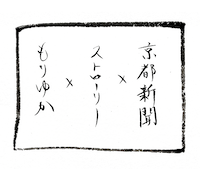 Stroly
Stroly
アンケートにご協力ください。
![]() Stroly
Stroly

本プロジェクトについて Stroly Inc.について 祇園祭絵地図のご利用について、アンケートにご協力お願いいたします 現地にいる方向け 遠隔地にいる方向け 本プロジェクトについて 京都新聞社とStroly Inc.でコラボレーションを行い、昨年に引き続き祇園祭を公開しました。今年は3年ぶりに山鉾巡行が執り行われることもあり、お家だけでなく、現地でも祇園祭を楽しめる仕掛けをたくさんご用意しております。 今年は、京都在住のイラストレーター、もりゆかさんによるイラストマップです。鳥獣戯画を彷彿とさせる軽やかなタッチで描かれた個性豊かなキャラクターが、祇園祭を楽しむ様子をご覧いただけます。 各山鉾ごとの由来や360度画像に加え、祇園祭に関連する神事や行事もご覧いただけます。ぜひ沢山の山鉾を巡って、祇園祭を余すことなくお楽しみください! 前祭絵地図 Stroly Inc.について Stroly(ストローリー) は、イラストマップをオンライン化するプラットフォームを運営しています。京都祇園祭開催地域の方々は、お手持ちのスマートフォンやタブレットのGPSを使って、現在地を確認しながら当コンテンツを楽しむことができます。現地に実際に行くことができない方は、マップにアクセスした際、キャラクターを選択いただくと、複数のユーザーと同時参加・会話ができます。
 祇園祭とは
祇園祭とは

由来と歴史 スケジュール 見どころ 使い方 このマップは2025年7月18日(金)〜31日(木)頃までの 祇園祭の山鉾情報をご自身の位置情報(GPS)と合わせて ご覧いただけるマップです。 是非、お気に入りの山鉾を見つけて ブックマークしてくださいね!! のマークをタップすると、 各山鉾の解説をご覧いただけます。 --> 祇園祭とは 日本の三大祭の一つに挙げられる祇園祭は、毎年7月1日から31日までの1カ月間、京都市内の中心部や八坂神社(東山区)で行われる。クライマックスの山鉾巡行や神幸祭をはじめ、多彩な祭事が繰り広げられる。 長刀鉾を先頭に河原町通りを進む山鉾。 夏の日差しに生える優美な須賀らを大勢の観客が見守った。 祇園祭の由来と歴史 平安時代前期の869(貞観11)年、京で疫病が流行した際、広大な庭園だった神泉苑(中京区)に、当時の国の数にちなんで66本の鉾を立て、八坂神社の神輿を迎えて災厄が取り除かれるよう祈ったことが始まりとされる。 応仁の乱(1467~77年)で山鉾巡行は途絶えたが、1500(明応9)年に町衆の手で再興された。 以後、中国やペルシャ、ベルギーなどからもたらされたタペストリーなどを各山鉾に飾るようになった。 これらの懸装品の豪華さゆえに、山鉾は「動く美術館」とも呼ばれる。 江戸時代にも火災に見舞われたが、町衆の力によって祭りの伝統は現代まで守られている。2009年にはユネスコ無形文化遺産に登録された。 山鉾巡行は本来、神輿渡御に伴う「露払い」の位置づけで、神幸祭に先立つ「前祭(さきまつり)」と還幸祭の「後祭(あとまつり)」がある。 高度成長期以来、交通渋滞や観光促進を理由に、前祭と後祭の合同巡行が続いていたが、 祭り本来の形を取り戻そうと分離が決定。2014年、約半世紀ぶりに後祭の山鉾巡行が復活した。 注連縄切りの大役を堂々と果たす長刀鉾稚児 祇園祭のスケジュール 毎年、7月1日の「吉符入り」で幕を開け、2日には山鉾巡行の順番を決める「くじ取り式」が京都市役所で行われる。 10日頃から前祭の鉾建てが始まり、12日頃には鉾の「曳初(ひきぞ)め」がある。 14日の宵々々山、15日の宵々山、16日の宵山を経て、17日は、前祭の23の山鉾が祇園囃子(ばやし)にのって京都のメーンストリートを巡行。 前祭山鉾巡行の翌日から、後祭に向けて鉾建てが始まる。 21~23日は宵山期間で、24日は後祭の山鉾巡行。 あわせて花笠巡行も繰り広げられる。夕方には、神輿が御旅所から神社に戻る還幸祭がある。 石段下を埋め尽くすように集まった担ぎ手たちが気勢を上げて3基のみこしを運ぶ。 祇園祭の見どころ 前祭・山鉾巡行まで12日頃の「曳初(ひきぞ)め」は、女性を含む一般市民も参加できることが多い。16日の宵山までは、各山鉾町ではちょうちんの明かりに照らされた山や鉾が楽しめる。各山鉾では、病気除けとされるちまきや、学問成就や立身出世などのお守り(護符)を手に入れることもできる。 前祭・山鉾巡行当日午前9時、計23基の山鉾が四条烏丸付近を出発。四条通を東へ向かった後、河原町通を北上し、御池通を西進する。四条麩屋町での長刀鉾稚児による「注連縄(しめなわ)切り」や、山鉾が各交差点で方向を変える「辻(つじ)回し」などが見どころ。 後祭・山鉾巡行まで前祭の山鉾巡行の翌日から、大船鉾の鉾建てが始まる。宵山では露店の出店が規制され、本来の祭り情緒が楽しめそう。 後祭・山鉾巡行当日午前9時半に計11基が烏丸御池を出発。前祭とは逆向きのコースを進む。復活した大船鉾や、前祭とは逆向きの辻回しなどに注目が集まる。 後祭列が復活するまで長らく代わりとなっていた花傘巡行の行列も、後祭列を追うよう御池通や河原町通を進む。 車輪をきしませながら「辻回し」を披露する長刀鉾 GPS機能について GPSをオンにします。オンの状態では、ボタンが青色に変わります。再びクリックすると、GPSがオフになります。 Q&A Q. 位置情報(GPS)の取得に失敗します。 ①位置情報の利用が許可されていない場合 「位置情報の利用が許可されていません」と表示される場合は、端末やブラウザで位置情報(GPS)の取得が許可されていません。端末側の設定をご確認ください。 ②現在位置の取得に失敗する場合/現在位置が時間以内に取得できない場合 屋内ではGPS信号の受信ができないことがあります。場所を変えてもう一度お試しください。 詳しくはこちら (c) The Kyoto Shimbun Co.,Ltd. All rights reserved.
